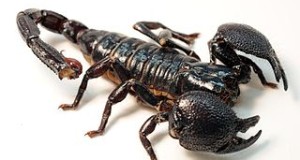The basic care of this scorpion parallels that which I described for emperor scorpions in the article Scorpions in Captivity – An Overview of Popular Species; Part II: The Emperor Scorpion (Pandinus imperator). I’ll highlight species-specific information below.
South African Rock Scorpion, Hadogenes troglodytes
Ranging throughout much of southern Africa, this scorpion giant (7.5 to 8.5 inches in length) is always found in association with rocky places, especially the savannah-based outcroppings know as kopjes. A thoroughly flattened body suits it especially well for climbing among and hiding within rock piles, a habitat it shares with the similarly-shaped flat rock lizards (Platysuarus spp.) and pancake tortoise (Malacochersus tornieri).
Color Variations
Rock scorpions vary greatly in color from population to population, and usually closely match the rocks of their habitat in hue. Tan, reddish, brown, olive and yellow specimens, and a variety of shades in-between, all appear in the pet trade from time to time.
Captive Habitat
In captivity, they should be supplied with ample climbing opportunities in the form of rock piles and plastic reptile shelters and caves. If you use natural rocks, be sure to place the base of the pile directly upon the terrarium floor, not on sand, so that the scorpions do not burrow below and become crushed. Repti sand makes a fine substrate.
The rock scorpion terrarium should be kept dry, with a light spraying of water once every 3-4 days being enough to supply their moisture requirements. A water bowl is not necessary.
Rock scorpions are rather shy and high strung, much more so than their more commonly-kept relative, the emperor scorpion. They will not thrive if forced to remain exposed. Given secure shelters, however, they readily settle into captive life and may very well reproduce once habituated. They are fairly slow-moving and seem to rely mainly upon their claws for defense. Their venom is not considered to be dangerous to healthy adults.
An American Museum of Natural History field report detailing Hadogenes natural history and the description of 2 new species is posted at:
http://research.amnh.org/users/lorenzo/PDF/Prendini.2006.AMN.Hadogenes.pdf
 That Reptile Blog – Reptile, Amphibian and Exotic Pet Care and Information
That Reptile Blog – Reptile, Amphibian and Exotic Pet Care and Information



Hi Frank – any idea why H. troglodytes seems to no longer be available in the hobby? It seems I only see H. paudicens offered anymore. Been looking for a mate for my lone female troglodytes (she of the long life span!), but no one has them anymore. Though having said that, back when I did have a pair, she would not tolerate the male in her cage and I had to keep them separated. (That’s how she got her name, too: Fury.) I always meant to introduce them under supervision some warm Spring evening, but sadly my male died before I had the chance.
Hello Raksha, Frank Indiviglio here.
Nice to hear from you again.
H. troglodytes is much more commonly available in the trade in Europe, and many zoos in Japan have them. In the USA availability of most scorpions is usually very sporadic; I don’t think there are many reliable breeders of other than the trade staples, and so much depends upon collectors, conditions in other nations and so on.
I’m waiting for some information on various invertebrates from 2 large importers. One often lists “Hadogenes spp”. One employee there is very knowledgeable and should be able to give me an ID. They only sell in volume, but I could find out who buys the scorpions and direct you to that store, if indeed they are the right species.
If you don’t mind, please send a reminder in 2 days or so to findiviglio@thatpetplace.com and I’ll let you know what turns up.
Best regards, Frank Indiviglio.
Hi again Frank … a couple of months ago I did finally find a male H. troglodytes to go with my 12-year-old female (he was my Christmas present to myself 🙂 ). Of course I don’t have them in the same cage together, as the female is quite aggressive toward her conspecifics. I would like to breed them, though. Any advice for introducing them safely?
Hello Raksha,
Nice to hear from you again. Intro’s can be tricky – I’d recommend introducing the female to the male’s terrarium, and keeping them separated by a screen barrier or Plastic Tank Divider for a few days. They see little if anything, but the divider may allow for some chemical/tactile communication. Be sure the terrarium has lots of cover to break up the floor space, and put them together when you’ll have plenty of time to watch; they may interact right away by day, but watch at night as well, as things can change then. A Night Viewing Bulb should be helpful, and be sure to have a long handled tongs ready in case you need to separate them.
Good luck, enjoy and please let me know how it goes,
Best regards, Frank Indiviglio.